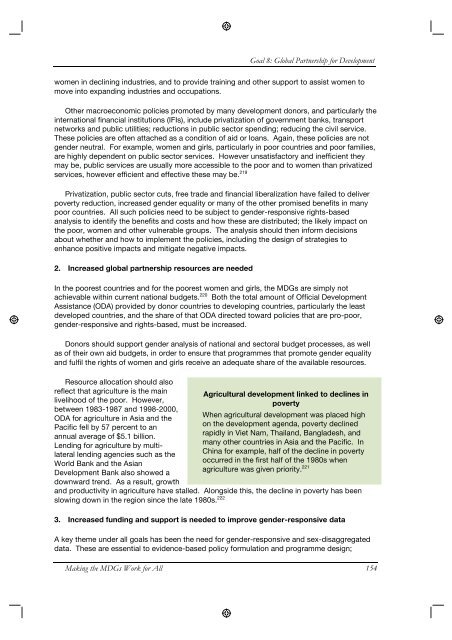Goal 8 - CEDAW Southeast Asia
Goal 8 - CEDAW Southeast Asia
Goal 8 - CEDAW Southeast Asia
You also want an ePaper? Increase the reach of your titles
YUMPU automatically turns print PDFs into web optimized ePapers that Google loves.
<strong>Goal</strong> 8: Global Partnership for Development<br />
women in declining industries, and to provide training and other support to assist women to<br />
move into expanding industries and occupations.<br />
Other macroeconomic policies promoted by many development donors, and particularly the<br />
international financial institutions (IFIs), include privatization of government banks, transport<br />
networks and public utilities; reductions in public sector spending; reducing the civil service.<br />
These policies are often attached as a condition of aid or loans. Again, these policies are not<br />
gender neutral. For example, women and girls, particularly in poor countries and poor families,<br />
are highly dependent on public sector services. However unsatisfactory and inefficient they<br />
may be, public services are usually more accessible to the poor and to women than privatized<br />
services, however efficient and effective these may be. 219<br />
Privatization, public sector cuts, free trade and financial liberalization have failed to deliver<br />
poverty reduction, increased gender equality or many of the other promised benefits in many<br />
poor countries. All such policies need to be subject to gender-responsive rights-based<br />
analysis to identify the benefits and costs and how these are distributed; the likely impact on<br />
the poor, women and other vulnerable groups. The analysis should then inform decisions<br />
about whether and how to implement the policies, including the design of strategies to<br />
enhance positive impacts and mitigate negative impacts.<br />
2. Increased global partnership resources are needed<br />
In the poorest countries and for the poorest women and girls, the MDGs are simply not<br />
achievable within current national budgets. 220 Both the total amount of Official Development<br />
Assistance (ODA) provided by donor countries to developing countries, particularly the least<br />
developed countries, and the share of that ODA directed toward policies that are pro-poor,<br />
gender-responsive and rights-based, must be increased.<br />
Donors should support gender analysis of national and sectoral budget processes, as well<br />
as of their own aid budgets, in order to ensure that programmes that promote gender equality<br />
and fulfil the rights of women and girls receive an adequate share of the available resources.<br />
Resource allocation should also<br />
reflect that agriculture is the main<br />
livelihood of the poor. However,<br />
between 1983-1987 and 1998-2000,<br />
ODA for agriculture in <strong>Asia</strong> and the<br />
Pacific fell by 57 percent to an<br />
annual average of $5.1 billion.<br />
Lending for agriculture by multilateral<br />
lending agencies such as the<br />
World Bank and the <strong>Asia</strong>n<br />
Development Bank also showed a<br />
downward trend. As a result, growth<br />
Agricultural development linked to declines in<br />
poverty<br />
When agricultural development was placed high<br />
on the development agenda, poverty declined<br />
rapidly in Viet Nam, Thailand, Bangladesh, and<br />
many other countries in <strong>Asia</strong> and the Pacific. In<br />
China for example, half of the decline in poverty<br />
occurred in the first half of the 1980s when<br />
agriculture was given priority. 221<br />
and productivity in agriculture have stalled. Alongside this, the decline in poverty has been<br />
slowing down in the region since the late 1980s. 222<br />
3. Increased funding and support is needed to improve gender-responsive data<br />
A key theme under all goals has been the need for gender-responsive and sex-disaggregated<br />
data. These are essential to evidence-based policy formulation and programme design;<br />
Making the MDGs Work for All 154

















